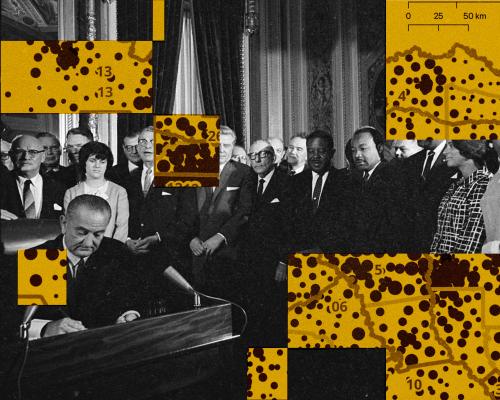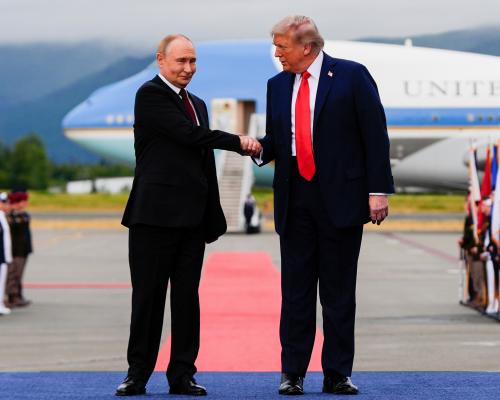
Facing images of violent white mobs defending racial segregation, the condemnation of the world and of its own citizens, Congress passed the Voting Rights Act, a law meant to end the hypocrisy of a democratic country that denied Black people the power of their vote.
Sixty years later, race remains at the center of American politics. Cases before the US supreme court, and a platoon of Texas legislators fleeing the state to prevent redistricting, demonstrate how the Voting Rights Act – and its erosion – remains on the frontline of the political battlefield.
“Democracy is at stake,” said Todd Cox, associate director-counsel for the NAACP Legal Defense Fund. Even as voting rights advocates use the act to win additional congressional representation in Alabama and press cases in Louisiana and North Carolina, a conservative supreme court makes gains precarious, he said.
“We wouldn’t be under such a threat if we weren’t doing so well in making sure our communities were engaged, that they were turning out and that their rights were protected,” Cox said. “This is a cyclical part of history, that when we see some success in advancing rights, there’s always backlash.”
Veterans of the struggle for civil rights view passage of the act as a revolutionary, historical demarcation point equal to the signing of the Declaration of Independence, Confederate general Robert E Lee’s surrender at Appomattox or the establishment of women’s suffrage. Enforcement of the Voting Rights Act fundamentally rewrote politics in America.
“I know I stand on the shoulders of folks … who fought and died in some cases,” Cox said.
Though constitutional amendments passed after the American civil war ended slavery and commanded racial equality before the law, American lawmakers regularly found ways to keep Black citizens from exercising political power. Literacy tests, poll taxes, separate ballot boxes for Black and white voters, white-only primary elections, purges of Black voters from the rolls and discriminatory district lines rigged elections for white voters in the US’s Jim Crow era.
Each time a court struck down a state law or demanded the end of a discriminatory practice, obstructionist local lawmakers – mostly but not exclusively in southern states – would quickly adapt, often enacting new election changes without enough time for a court to intervene. Civil rights laws at the time held insufficient authority to stop the practice.
After years of campaigns for voting rights and racial equality across the south, the civil rights struggle came to a head in March 1965 in Selma, Alabama. The death of Jimmie Lee Jackson, a Baptist deacon and local voting rights activist, at the hands of state troopers led 600 people to march across the Edmund Pettus Bridge.
State troopers attacked demonstrators with truncheons and teargas. As networks broadcast the assault, the US watched future US representative John Lewis get beaten into unconsciousness by white police officers live on national television. Support crystalized for civil and voting rights after the events of the “Bloody Sunday” broadcast.
Congress wrote the Voting Rights Act to prevent the case-by-case whack-a-mole games local lawmakers were playing with election rules. It forced jurisdictions with a history of discrimination to clear elections changes with the Department of Justice before they could go into effect. It banned literacy tests to vote and allowed challenges to district maps when those maps would not allow proportional representation for minority voters.
The principles of the Voting Rights Act have shaped the way lawmakers from the halls of Congress to a city council hearing room have to respond politically to voters of color.
Congress has reauthorized the Voting Rights Act four times since its enactment, each time under a Republican president. But the law’s protections have suffered a death of a thousand cuts.
In the Shelby County v Holder case of 2013, the US supreme court held that the data defining jurisdictions with a history of discrimination was too old to be relied upon; Congress must update it for the Voting Rights Act’s pre-clearance rules in Section 5 to remain constitutional, the court ruled. Republicans in Congress have blocked legislation – the John Lewis voting rights advancement act – updating the law, effectively ending pre-clearance.
“It was a pretty significant blow to the project of ensuring voting free of racial discrimination in this country,” said Sophia Lin Lakin, director of the ACLU’s voting rights project. “I think it really accelerated in this moment the attacks on voting access across the country.”
States previously restricted by pre-clearance enacted a wave of election legislation following the ruling, closing polling places, changing voter registration rules and redrawing district lines unhindered.
The 5-4 decision in Rucho v Common Cause in 2019 further eroded the power of the Voting Rights Act, by explicitly permitting political gerrymandering, even as racial gerrymandering remained off-limits.
The mid-decade redistricting in Texas proposed by Donald Trump presents a particularly vivid example of the consequences of an end to pre-clearance and recent supreme court decisions. Democratic state representatives have fled the state to deny Republicans a quorum to pass the redistricting legislation, which would likely grant Republicans an additional five congressional seats in Texas by concentrating some minority voters into fewer districts while diluting clusters of other voters.
“Those maps would have had to be reviewed by the federal government coming in after the fact to challenge them, and winning,” Lakin said.
In 2003, the eighth circuit federal appellate court further restricted the use of the Voting Rights Act, ruling in Arkansas State Conference NAACP v Arkansas Board of Apportionment that private groups do not have a right to challenge state election laws under the act; only the Department of Justice can bring a voting rights case to court. A second eighth circuit decision extended the ban on private voting rights suits from redistricting cases to suits challenging restrictions on voter assistance.
Of the 180 or so successful claims brought under the Voting Rights Act, only 15 have been brought by the Department of Justice, said Jacqueline De León, senior staff attorney with the Native American Rights Fund. The Department of Justice’s voting rights division used to have about 30 staff attorneys; under the Trump administration, it has lost all but two or three, she said.
“We know the Department of Justice is not going to be in the business of enforcing voting rights,” De León said. “Right now, we don’t know if there will be a future where a Voting Rights Act is available to our country. This is really a moment for concern and reflection on this anniversary.”
Lakin said she expects the eighth circuit ruling to be appealed to the supreme court.
Meanwhile, a case in Louisiana that has reached the US supreme court threatens the last leg standing of the Voting Rights Act.
On Friday, the court signaled that it will consider the constitutionality of section 2, asking for supplemental briefs in Louisiana v Callais. The case, to be heard later this year, asks whether the state’s creation of a majority-minority congressional district violates the 14th or 15th amendment to the constitution.
“I think this is, unfortunately, another opportunity for the court to continue to attack this pillar of our democracy, the Voting Rights Act,” Lakin said.
In Callais, a group of “non-African-American voters” filed suit against the state of Louisiana, arguing that lawmakers acting on the order of the federal court drew a congressional district map that unconstitutionally considered race.
The Equal Protection Clause of the US constitution and the 15th amendment’s guarantee that the right to vote cannot be denied because of race says that lawmakers cannot consider race predominantly over other factors when redistricting without a compelling reason. But section 2 of the Voting Rights Act requires lawmakers to consider race when it is necessary to ensure that the voting power of racial minorities has fair representation.
The cases are an effort to create conflict between the Voting Rights Act and the constitution as a rationale for a conservative court to chip away, Lakin said.
“Congress can enact laws to ensure the 14th and 15th amendments are given life,” she said. “I think that there’s an attempt to create tensions around this and say that there’s a disconnect with the Voting Rights Act. But as the supreme court has stated … the act is a properly, constitutionally authorized use of Congress’s powers.”
Such a finding would turn hard-fought civil rights law on its head. It would establish a legal basis for white voters to challenge laws meant to protect minority voters from discrimination.
“I would say it’s a perversion of what the Department of Justice has symbolized, specifically what its historic role, its purpose was meant to be,” Lakin said.





